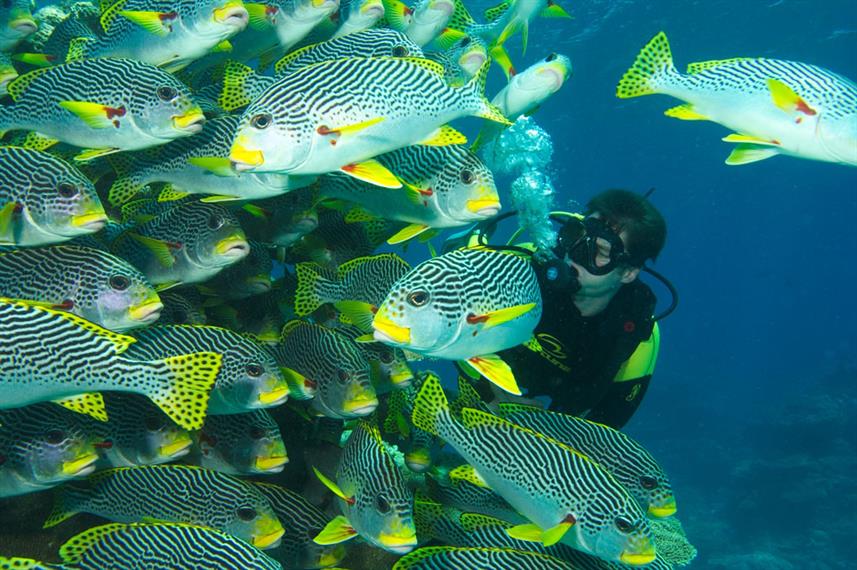
Updated March 20, 2022
This is the one hundred and fifty-forth in a series of reviews of the best dive resort locations around the world. In this post, the focus is on Port Douglas, Australia. In addition to this series on dive resort locations, the best worldwide liveaboard diving locations and services are reviewed in their own series. To check them out, or others in this series, click on Liveaboards/Resorts on the menu at the top and choose a title from the list.
Have you been diving in Port Douglas before? If so, I’d love to know about your experience. What dive shop or liveaboard did you use? Which dive spots are the best and what are the conditions there regarding the visibility, current, water temperature, sealife attractions, etc.? Please post your response in the comments section at the bottom and we’ll all learn something we can use.
Scuba Diving from Port Douglas Australia
 Background
Background
Port Douglas is located in the far north of Queensland 70 kilometers (44 miles) from Cairns on a coastal strip between the Great Dividing Range and the Coral Sea.
Established in 1877 as a center of mining and timber, today the population of 3,500 is sustained through tourism based on the tropical climate, beautiful rainforest and waterways, and easy access to the Great Barrier Reef. From May to September during the peak tourist season, the population doubles. For further historical and demographic information, please go to Wikipedia-Port Douglas.
Undersea World
Most of the liveaboards for the top sites on the Great Barrier Reef depart from Cairns. There are sites on the outer reef like the 45 or more on the Agincourt Reef that are superior, that can be accessed on day trips within a couple of hours from Port Douglas.
The inner reef, while not quite as spectacular, provides excellent shallow sites for training, recreational diving, and snorkeling that are very convenient and have colorful coral gardens with a nice mix of marine life. The outer reef sites, closer to the continental shelf, have a more varied undersea topography of coral bommies, walls, ledges, canyons, and shoals with the possibility of current on some sites.
The pristine reefs of the Great Barrier Reef have seen some coral bleaching in 1998, 2002, and 2015, but after a few years of recovery, it is not a major blemish in most areas. The diversity is still unmatched with a great variety of species across fish, hard and soft corals, crustaceans, mollusks, sharks and rays, and marine mammals. The reefs are covered with an array of encrusting hard and soft corals, gorgonians, and other invertebrates. Macro photographers have many excellent targets and there are opportunities for megafauna on every dive. Numerous shark and ray species are often seen especially reef sharks and stingrays on the sites near Port Douglas. Several sea turtle species are common along with bottlenose dolphins and seasonal visits from humpback whales from June through November and Minke whales from June through August.
Seasons and Conditions
Diving is possible all year in Port Douglas.
- Air temperature average daily highs reach 30.3°C (86.5°F) in December and January and dip to 24.6°C (76.3°F) in July.
- The rainy season in Port Douglas runs from November through May with a possibility of cyclones. The heaviest rains are from January through March. Rains generally come early in the morning or in the late afternoon. From June through October is the dry season.
- The water temperature reaches highs of 29°C (84.2°F) from December through February with the lows from June through August of 22°C (71.6°F). During the warmest times, a 3mm wetsuit is probably sufficient. When the water is at its coolest, many will use a 5-7mm wetsuit.
- Currents are often mild on the dive sites on the Outer Reef around Port Douglas. On some of the distant sites closer to the continental shelf, they can be strong.
- Visibility is usually from 10-40 meters (33-130 feet). Under some conditions of wind and weather, it can get down to 5 meters (16 feet).
- There are sites suitable for all levels of diver from beginner to advanced levels. Dozens of dive shops are in operation that can provide a full range of diving coursework, equipment rental, guiding, and boat cruises.
For information about cold water gear, please check out my review:
Liveaboard Diving
There are a number of liveaboard yachts cruising the Great Barrier Reef. Ocean Quest and Coral Sea Dreaming go to the Outer Reef to sites relatively close to Cairns including Flynn, Milln, Thetford, and Pellowe Reefs. The MV Scubapro I travels a bit further to sites to the north fairly close to Port Douglas including Norman, Saxon, and Hastings Reefs. The MV Spirit of Freedom and MV Spoilsport go to the most distant sites like Cod Hole, the Ribbon Reefs, and the Coral Sea.
Ocean Quest, Great Barrier Reef (Outer Reef) Liveaboard – Check the Price
MV Scubapro I, Great Barrier Reef (Outer Reef) Liveaboard – Check the Price
Coral Sea Dreaming, Great Barrier Reef (Outer Reef) Liveaboard – Check the Price
Spoilsport, Great Barrier Reef (Coral Sea, Cod Hole, Ribbon Reefs) Liveaboard – Check the Price
Numerous liveaboard yachts also cruise to other areas in Australia including Rowley Shoals, Neptune Island, and Ningaloo Reef. Here are my reviews on Australian diving and some of the liveaboard yachts diving other Australian sites:
- Best Diving Australia Liveaboards
- Scuba Diving Western Australia Ningaloo Reef Liveaboard
- Townsville Australia Diving
- Scuba Diving the Whitsundays Australia
- Scuba Diving Cairns Australia
- Gold Coast Scuba Diving Australia
- Brisbane Australia Scuba Diving
- Scuba Diving in Melbourne Australia
- Best Scuba Diving Sydney Australia
- Best Scuba Diving Perth Australia
- Scuba Diving Tasmania
MV Odyssey, Rowley Shoals Liveaboard Diving – Check the Price
Princess II, Neptune Island Shark Cage Diving Liveaboard – Check the Price
Shore Thing, Ningaloo Reef Liveaboard – Check the Price
 Selected Port Douglas Diving Sites
Selected Port Douglas Diving Sites
Harry’s Bommie (Agincourt Reef 4-Site 1): 16 meters (52 feet), reef spread around pinnacles and patch reefs, split in two with a gap where some current is possible, section with lots of plate and staghorn corals, highlights include big schools of fusiliers, juvenile grey reef sharks, and an occasional manta ray, suitable for all levels of diver
Horseshoe (Agincourt Reef 2-Site 14): 20 meters (68 feet), patch reef with significant tidal movement, current possible in some sections, reef with branching and plate corals, sandy area with garden eels, giant clams, and possible green turtles, other highlights include red bass, bigeye jacks, Goldman’s sweetlips, and bumphead parrotfish numbering from 10-30, suitable for all levels of diver
Three Sisters (Agincourt Reef 4-Site 2), 20 meters (68 feet), named for 3 pinnacles, 2 options for diving, 1 ) stay around the pinnacles and the narrow canyons there, mild steady current, highlights to look for include grey reef sharks that are very commonly seen, coral trout, red bass, sweetlips, Queensland groupers, cod, huge schools of anthias and fusiliers, feather stars, sea cucumbers, sea apples, and anemones with their clownfish, 2) go to the coral garden area on the sheltered side, patch reef with multiple species of hard corals including big coral boulders 300 years in age, lots of small to medium-sized reef tropicals with butterflyfish, parrotfish, anemones and clownfish, and big giant clams, suitable for all levels of diver
The Point (Agincourt Reef 4-Site 04): 25 meters (82 feet), located on the southwest point of Reef 4, make your entry into the protected lagoon coral garden area first, look for sweetlips, Maori wrasses, many species of parrotfish, and giant clams, from there go around the point to the deeper wall along the channel, look for red bass, silver drummers, schools of bigeye jacks and barracudas, grey and whitetip reef sharks, and schools of anthias, fusiliers, and unicornfish, and sea cucumbers, suitable for all levels of diver
Nursery Bommie (Agincourt Reef 2-Site 17), 24 meters (80 feet), pinnacle located behind a ribbon reef from 16-24 meters (52-80 feet), current is possible, look for pickhandle barracuda, whitetip and blacktip reef sharks, schools of drummer, unicornfish, surgeonfish, and foxface rabbitfish, blue-spotted lagoon rays and garden eels in the sandy bottom, featherstars and moray eels along the wall, in the shallows behind the ribbon reef are staghorn and boulder corals, and anemones and their partner clownfish and pink anemonefish, suitable for all levels of diver
The Gardens (Agincourt Reef 2-Site 12), 10 meters (33 feet), sheltered coral garden in a lagoon, lots of boulder, plate, and shrub corals, and soft corals, reef tropicals include parrotfish, Maori, and other species of wrasse, goatfish, butterflyfish, sweetlips, and triggerfish nesting in summer, big schools of baitfish often chased by pelagics, suitable for all levels of diver
Wreck (Agincourt Reef 3-Site 09): 22 meters (72 feet), large sandy bay with pinnacles and coral gardens, 70-year-old Taiwan fishing boat wreck that still has parts remaining including the engine block, cooling pips, plate, anchor, and other bits, rich in hard corals with boulder, shrub, plate, and branching corals, and some sandy areas, marine life includes sweetlips, fusiliers, and anemones and their partner fish, suitable for all levels of diver
Things to Do in Port Douglas (aside from scuba diving)
Port Douglas not only offers some of the best diving on the planet, the rest of the outdoor scene in the rainforest and along the coastline is equally intoxicating. There are activities and sights for the whole family. Here are some to consider: Sunday Market, Chili’s Pizza and trattoria, Betty’s Bohemian Beach Café, Mossman Gorge, Star of Siam Restaurant, Cane Toad Races, Macrossan Street (shopping), Rex Smeal Park, Stand-up Paddleboarding, Gelato and Sorbet, Sejuice (healthy food), Palm Cove, Four Mile Beach, Trinity Bay Lookout, Helicopter Tour, Flagstaff Hill, Crocodile Farm, Crystalbrook Superyacht Marina, Wildlife Habitat, St. Mary’s by the Sea, Court House Hotel, Daintree River and Rainforest, Cape Tribulation, Kite Surfing.
This video is a nice introduction and overview of what Port Douglas has to offer.
Port Douglas Transportation, Hotels, & Diving Services
Transportation
- Air – Cairns International Airport (CNS) is the closest to Port Douglas about an hour’s drive away. It has international and domestic terminals within walking distance of each other. International destinations served are Tokyo, Bali, Singapore, Port Moresby, Auckland, and Hong Kong. Frequent flights are available to all the major Australian cities. Sun Palm is a shuttle service that can be boarded at the airport or in town for the trip to Port Douglas. Exemplar Coaches and Limousines is another service making the trip. I suggest checking with your hotel for pick-up, as well
- Car rental is available from several agencies at the airport.
- Public Bus – Two bus systems are in operation in Port Douglas with 4 per hour running from 7 am to midnight.
- The main downtown area is small enough for all destinations to be accessible on foot from lodging nearby.
For more details related to transportation options and other tourist information, go to Wikitravel-Port Douglas.
Hotels and Diving
In Port Douglas, there are at least 65 lodging options ranging from $11-$431 per night and a dozen or more dive shops in operation. They offer a full range of services that include equipment rental, diving certification classes, dive guides, and boat tours.
The website linked below has the details and can arrange a booking for the lodging. You can easily find the location on the map provided on their site. The rates are guaranteed to be the lowest and it is free to cancel or change dates.
Photography in Port Douglas
With the colorful coral reefs, a variety of fish, rays, sharks, dolphins, and intriguing onshore targets, as well, there are many excellent photo opportunities. For information and reviews of dive cameras, click here:
Scuba Diving Trip Insurance
A cushion for emergencies provides peace of mind when on vacation. I recommend this diving insurance as they have worldwide coverage and give scuba divers quality insurance and medical assistance service.
Feedback and Comments
I hope you found this post on Port Douglas scuba diving interesting and useful. If you have any questions or ideas, please feel free to share them in the comments section. I’d love to know of any experience you have. If there is no comments section directly below, click here: >>comments<<
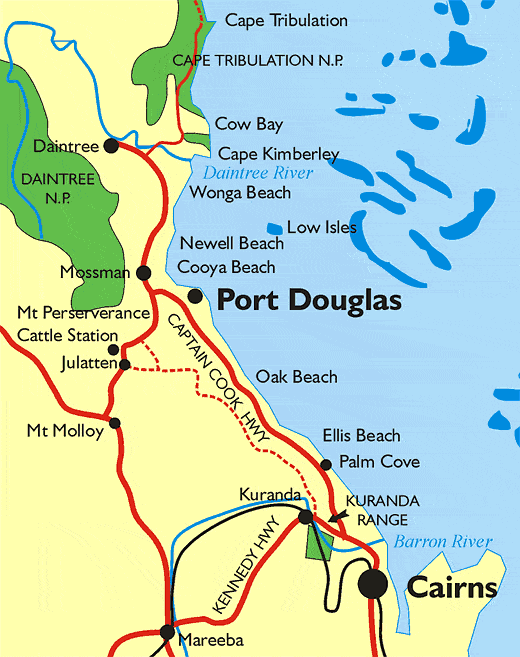 Background
Background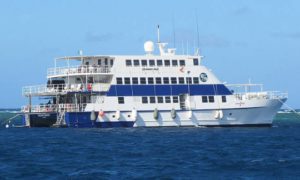
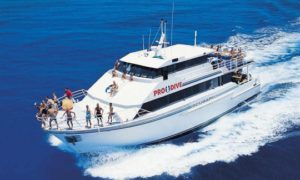
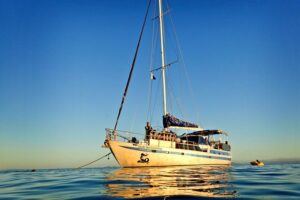
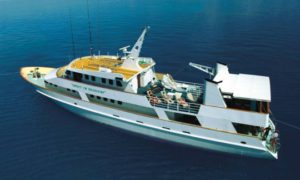
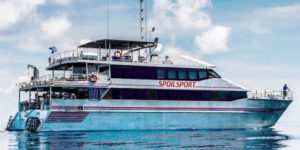
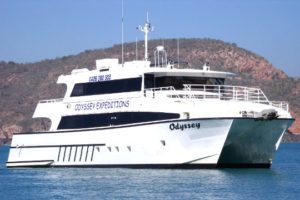
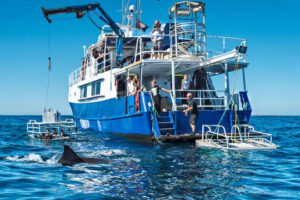
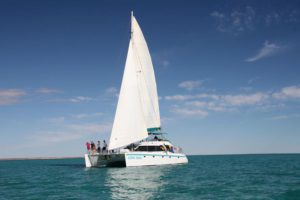
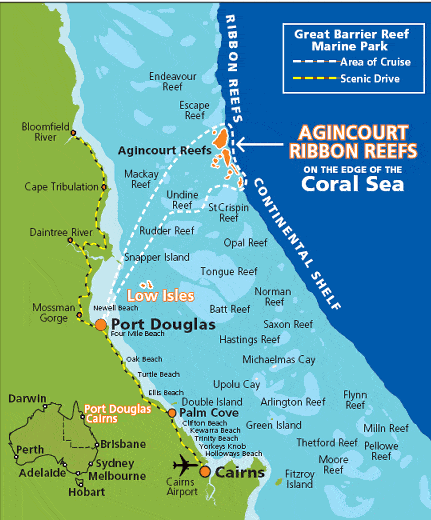 Selected Port Douglas Diving Sites
Selected Port Douglas Diving Sites

Leave a Reply